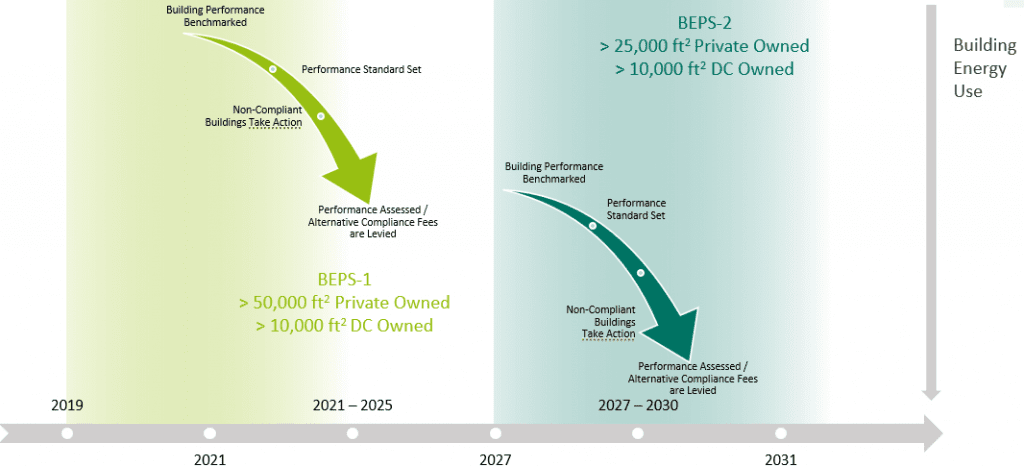The District of Columbia’s Building Energy Performance Standards (BEPS) is now in full effect. This blog series will give you a breakdown of BEPS, its requirements, deadlines, compliance pathways, and strategy and implementation. In Part 1 of the blog series, we will explain what BEPS is, how to determine if your property complies with BEPS, the four compliance pathways, and the steps you can take now to get on a path towards compliance.
In January of 2021, the City of Washington DC published its Building Energy Performance Standards (BEPS). In simple terms, the published standards established minimum levels of energy performance that existing DC buildings are required to meet. The standards were set by building type based on 2019 benchmarking data. Furthermore, they were set to be the median performance level or higher for each building type. For example, the standard for multifamily buildings is that they must achieve an Energy Star Score of 66 or higher and an office building must achieve an Energy Star Score of 71 or higher. For property types that cannot earn an Energy Star Score, BEPS is based on a maximum allowed source energy use intensity (EUI). For example, indoor arenas must have a source EUI of 240.2 kBtu/ft² or less to comply.

Determining DC BEPS Compliance
BEPS will be set on a six-year cycle. This first BEPS cycle (BEPS-1) applies to city-owned properties 10,000 ft2 and larger and privately owned properties 50,000 ft2 and larger. The next BEPS cycle (BEPS-2) will go into effect on January 1, 2027 and will add privately owned properties 25,000 ft2 and larger. It is anticipated that with each new BEPS cycle the energy performance requirements will become more stringent as buildings decrease their energy consumption. That is, the minimum required Energy Star Scores will increase and the maximum allowed source EUIs will decrease.

To determine if your property complies with BEPS-1:
- Visit the DC Building Energy Benchmarking Disclosure webpage
- Search for your property using the tools in the bottom right-hand corner of the map. More information on how to find your property’s BEPS status can be found on this website.
Once you have found your property, check the details in the “Building Energy Performance Data” pop-up window to see if your property complies with BEPS. If your property complies with BEPS-1, then you are generally fine for now. However, keep in mind that BEPS requirements are expected to rise over time. So, compliance today does not necessarily mean that you will comply when BEPS-2 starts on January 1, 2027.
If you have determined that your property does not comply with BEPS-1, then you will want to start taking steps to determine how best to comply. The first thing you should do is verify your 2019 benchmarking data to make sure that it is correct. Once that is done and you still do not comply, then you should become familiar with the compliance pathways and how to proceed with each. Depending on your property’s situation, your best options for compliance will vary.
DC BEPS Compliance Pathways

With respect to how buildings can comply if they do not meet BEPS, if a building does nothing, it may be required to pay an alternative compliance penalty of up to $10 / square foot of building area (capped at $7.5 million). This means a 50,000 ft2 building faces a penalty of up to $500,000. To avoid penalties, properties can follow one of four compliance pathways. These are:
- Performance- reduce site energy use by 20%
- Standard Target- achieve the BEPS required score by the end of the current compliance cycle.
- Prescriptive- complete a specific, DOEE agreed to set of measures by the end of the compliance cycle
- Alternative- complete an alternative approach agreed to by DOEE that achieves the equivalent or greater energy savings than would be achieved via the Performance, Standard, or Prescriptive pathways

Besides understanding the basics of BEPS, it is also important to know that there are key dates to be aware of for BEPS-1:
- Property owners need to select a compliance pathway by April 1, 2023
- Measures generally need to be completed by the end of 2025
- Performance/compliance will be evaluated based on 2026 operations
- Determination of compliance will happen in 2027
In addition, property owners should be aware that BEPS-2 will start January 1, 2027, and will be based on 2025 benchmarking data. This is one year earlier than the compliance evaluation for BEPS-1 based on 2026 benchmarking data. The years were originally the same but shifted due to COVID-19.
Steps Towards BEPS Compliance
Finally, it is important to understand the practical, non-regulatory steps that BEPS will require property owners and operators to take. First and foremost, for non-compliant properties, owners need to identify and take steps to reduce building energy use. In some cases, especially if the Energy Star Score is close to the standard, ways to save energy may be obvious such as upgrading lighting or repairing malfunctioning systems. Implementing such obvious measures may be done within a short time and the impact can be quickly evaluated to determine if a building will comply. However, in most cases, more effort will be required. This typically means completing a property-specific energy audit which identifies possible energy efficiency measures (EEMs) and quantifies each measure’s potential to reduce energy use.

This table shows a partial list of EEMs identified during an energy audit.
An energy audit provides property owners with a list of EEMs that save energy. However, to realize energy savings, property owners must implement these measures. These measures range from simple and quick to complex and time-consuming. Ideally, it is best to implement easy, low-cost measures first and then implement more complex measures. However, due to the BEPS time frame, property owners will have to initiate both simple and complex measures from the start to ensure compliance. Lead times for building materials have significantly increased and high utilization of contractors also warrant initiating the implementation of EEMs sooner than later.
It is important, and a first great step, for building owners to become familiar with DC’s BEPS and its requirements. And if your property is non-compliant, it’s crucial to continue taking steps to determine how to best comply. An energy audit is usually the recommended next step. It provides building owners with a list of EEMs that save energy and that they can start implementing now. In Part 2, we will discuss the DC BEPS key dates that you need to keep in mind.
Are you uncertain about what to do next or have any questions? Contact us!







